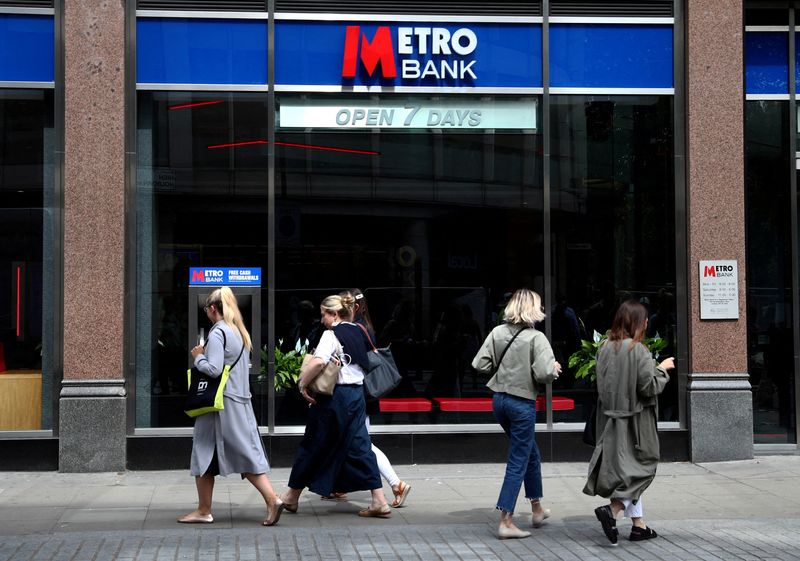By Lawrence White
LONDON (Reuters) - Mid-sized British lender Metro Bank saw its shares plunge more than 25% on Thursday following reports it is trying to raise as much as 600 million pounds ($729 million) to strengthen its capital levels.
It is another setback for the upstart lender, launched in 2010, which at one time looked like the best bet to shake up a banking market dominated by behemoths like Barclays (LON:BARC), Lloyds Banking Group (LON:LLOY) and NatWest (LON:NWG).
WHY DOES METRO BANK NEED TO RAISE FUNDS?
Metro Bank has faced persistent struggles in recent years to convince regulators that it can use its own models when working out how much capital it needs.
The bank said in September its principal regulator had indicated more work would be needed before it could use those models in its residential mortgage business, in turn lowering capital requirements.
Sources told Reuters the bank may need 100 million pounds in additional equity.
Metro Bank also has 350 million pounds of debt maturing in 2025 which it needs to refinance soon, although the company has stressed it meets its minimum regulatory capital requirements.
Ratings agencies and analysts say any future fundraising could be expensive.
WHY IS METRO BANK DIFFERENT FROM OTHER BANKS?
Besides meeting its existing debt obligations, Metro Bank has an expensive business model to support. It is mainly funded by retail and business deposits at a time when sharply rising interest rates in the last year have pushed up deposit pricing as customers shop around for better rates.
Those pressures have raised questions about the sustainability of its high-cost, service-focused model, which includes a significant branch network.
WHO BANKS WITH METRO AND IS THEIR MONEY SAFE?
Metro Bank targets urban retail customers in British cities with outlets strategically placed in prime shopping areas.
It has also attracted business from wealthier customers through its provision of safe deposit boxes in branches, a traditional banking service that had fallen out of fashion among many rivals.
Retail depositors' savings of up to 85,000 pounds are covered by a government guarantee in Britain, unlike the mainly business-originated deposits held by U.S. lender Silicon Valley Bank, which failed earlier this year.
HOW SIGNIFICANT IS METRO BANK IN THE UK?
With net assets of 21 billion pounds and customer deposits of 15.5 billion pounds as of June 30, Metro Bank remains a relative minnow in the UK banking market. Lloyds, for example, has more than 880 billion pounds in assets and 470 billion pounds in customer deposits.
With its network of 76 branches, which it calls stores, and ambitions to open 11 more across northern England in 2024 and 2025, Metro Bank aims to exert influence on the market beyond its size by highlighting its customer service.
It claims the longest opening hours of any high street bank, with stores typically open from 8:30 a.m. until 6:00 p.m., and from 11:00 a.m. until 5:00 p.m. at weekends, at a time when rivals have been slashing hours as well as axing branches.
ARE WE LIKELY TO SEE CONTAGION?
For now, Metro Bank's issues are likely to be self-contained, since its idiosyncratic branch-focused, high-cost business model and issues with regulatory capital are not widely replicated across the sector.

Shares in other mid-sized British banks such as Virgin Money (LON:VMUK) were flat on Thursday, indicating that investors do not see any contagion risks for now.
($1 = 0.8235 pounds)